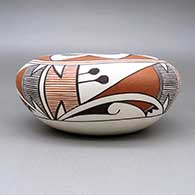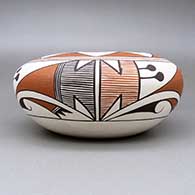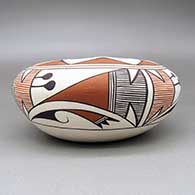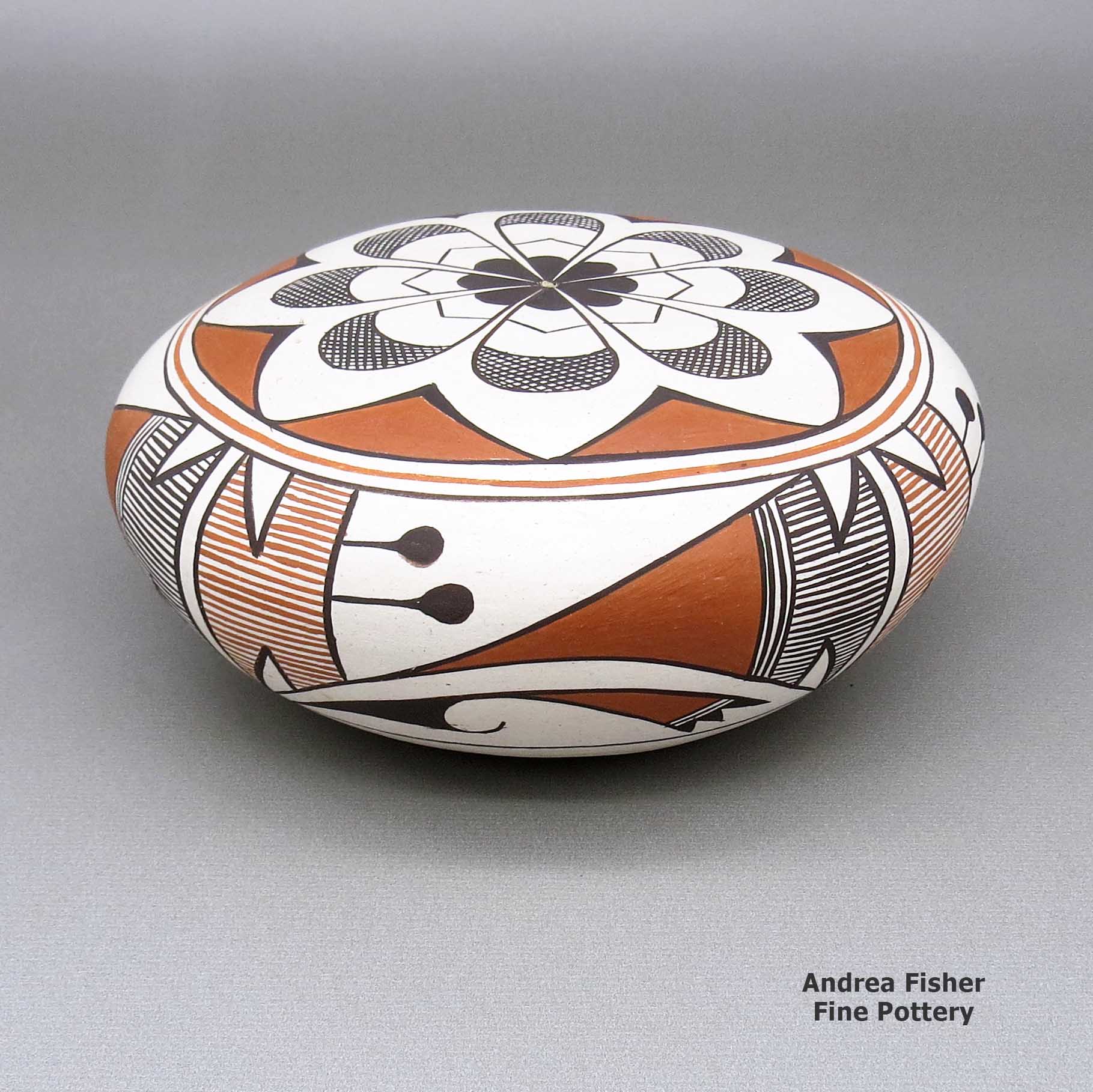
Laguna
$ SOLD
shla4c092
Polychrome seed pot with a fine line, medallion, and geometric design
6.25 in L by 6.25 in W by 2.75 in H
Condition: Very good, has rubbing on bottom, pitting, and normal wear
Signature: L.A. Cheromiah Old Laguna, N.M., with hallmark
Tell me more! Buy this piece!
(505) 986-1234 - www.andreafisherpottery.com - All Rights Reserved
Lee Ann Cheromiah
Laguna
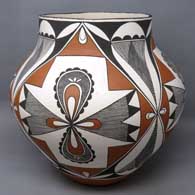
Born into the Laguna Pueblo Roadrunner Clan in 1954, Lee Ann Cheromiah is the daughter of Evelyn Cheromiah. Evelyn is credited with helping to revive the Laguna pottery tradition that had almost completely ceased in the 1950s. Lee Ann learned her craft from Evelyn as she grew up.
Rick Dillingham said "Evelyn and Lee Ann Cheromiah 'talk' to the spirits of deceased potters while making new pottery, to guide them in their work." Lee Ann called it the Spirit of the Clay: "Sometimes the Clay will take over and do what She wants. If She doesn't like the design, it won't work."
Lee Ann earned several ribbons at the Santa Fe Indian Market and at the New Mexico State Fair. She generally makes traditional polychrome jars, bowls and animal figures, decorated with traditional Laguna geometric designs.
Lee Ann passed her knowledge and skills on to her daughter, Brooke. Lee Ann usually signs her pieces: L.A. Cheromiah, Old Laguna N.M.
Laguna Pueblo
After the Pueblo Revolt of 1680, many Puebloans were fearful of Spanish reprisals. Spanish militias returned in 1681 and again in 1689. That first return brought them as far north as Isleta and that pueblo was attacked, looted and burned. The second return saw troops marching up to Santa Ana and San Felipe, attacking, looting and burning both. In those years, when the Puebloans became aware of approaching Spanish forces they mostly scattered into the mountains and the Spanish found empty pueblos, easy to loot and easy to burn. When Don Diego de Vargas marched north in 1692, he was intent on reconquering Nuevo Mexico and re-establishing a long-term Spanish presence there. As the conquistadors who accompanied him were on a "do-or-die" mission, the reconquest took on a tenor quite different from the previous missions...
At first de Vargas followed a path of reconciliation with the pueblos but that was soon replaced with an iron fist that brought on a second revolt in 1696. The pueblos didn't fare so well the second time around and a large number of Pueblo warriors were executed while their wives and children were forced into slavery. When word of de Vargas actions got back to the King of Spain, he ordered de Vargas banned from the New World. However, most of the damage was already done.
Many modern historians say Laguna Pueblo was established between 1697 and 1699 by refugees seeking to avoid fighting with the Spanish. Many of those refugees had left the first pueblos approached by the Spanish in 1692. They had first scattered to more remote places like Acoma, Zuni and Hopi, or to more Spanish-friendly Isleta. However, the pressure of those refugees strained the resources of the other pueblos and quickly forced the refugees to consider starting a new existence in a newly-formed pueblo. The area of Laguna had been settled several hundred years previously by ancestors of today's tribe but had been abandoned during the periods of great drought that had brought the Ancestral Puebloans (Anasazi) down from the Four Corners area to the areas where we now find the Rio Grande Pueblos. Some of the land under Laguna control has also been found to contain archaeological resources dating as far back as 3,000 BC. The prehistoric village of Pottery Mound is located just east of today's Laguna Pueblo boundary. Pottery Mound was abandoned long before the Spanish first arrived but archaeologists have followed the tracks left by Pottery Mound styles, shapes and designs to settlements in the Hopi mesas and the Four Corners area.
Over time, several villages were established in the area around Old Laguna and when the Lagunas were granted their own reservation, they were given about 500,000 acres of land, making Laguna one of the largest of all pueblos in terms of land. However, only about half the enrolled members of the tribe live at Laguna as many have been drawn to nearby Albuquerque in search of work.
Laguna and Acoma share the same language (Western Keresan), similar pottery styles and similar religious beliefs. However, pottery making almost died out at Laguna after the railroads arrived in New Mexico in 1880 and laid a primary east-west trackbed directly in front of the Laguna main pueblo. During that time period many Lagunas went to work on railroad construction crews and many of the traditional Laguna arts and crafts died out. Potterymaking never completely stopped at Laguna but by 1960 it was almost gone. Then in 1973 and again in 1974 Nancy Winslow taught two four-month arts and crafts classes at the pueblo. Among the 22 pueblo members in the first class were Evelyn Cheromiah and her daughters. Rick Dillingham quoted Evelyn Cheromiah as saying that after "looking at my mother's pottery-making tools, I got the urge of going back to making pottery." That was the beginning of today's renaissance in Laguna pottery.
Because of their geographic proximity, Laguna and Acoma clays are very similar. In some instances, it's very hard to determine if a particular pot is from Acoma or from Laguna. Laguna potters are more likely to temper their white clay with sand than with ground up pot shards like the Acomas do. Laguna geometric designs also tend to be bolder than Acoma designs while Laguna potters use Mimbres designs much more sparingly than do Acoma potters.
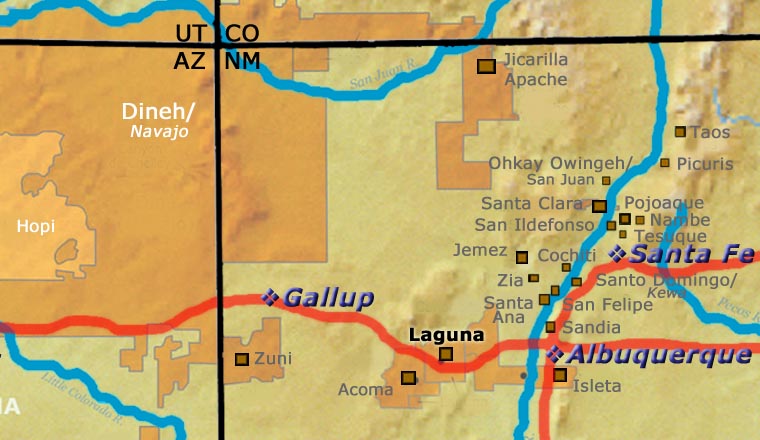
Seed Pots
Acoma, Hopi, Isleta, Jemez, Laguna, San Felipe, San Ildefonso, San Juan, Santa Clara
Acoma Pueblo
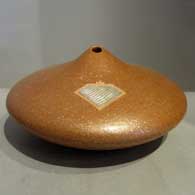
Hopi
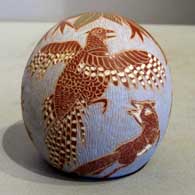
Santa Clara Pueblo
It was a matter of survival to the ancient Native American people that seeds be stored properly until the next planting season. Small, hollow pots were made to ensure that the precious seeds would be kept safe from moisture, light and rodents. After seeds were put into the pot, the small hole in the pot was plugged. The following spring the plug was removed and the seeds were shaken from the pot directly onto the planting area.
Today, seed pots are no longer necessary due to readily available seeds from commercial suppliers. However, seed pots continue to be made as beautiful, decorative works of art. The sizes and shapes of seed pots have evolved and vary greatly, depending on the vision of Clay Mother as seen through the artist. The decorations vary, too, from simple white seed pots with raised relief to multi-colored painted, raised relief and sgraffito designs, sometimes with inlaid gemstones and silver lids.
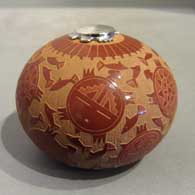
Santa Clara Pueblo
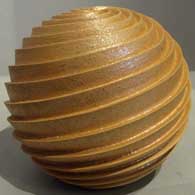
Jemez Pueblo
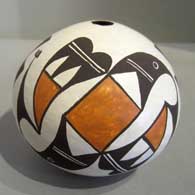
Acoma Pueblo
Evelyn Cheromiah Family and Teaching Tree
Disclaimer: This "family tree" is a best effort on our part to determine who the potters are in this group and arrange them in a generational order. The general information available is questionable so we have tried to show each of these diagrams to living members of each family to get their input and approval, too. This diagram is subject to change should we get better info.
Evelyn worked with Nancy Winslow, an Anglo woman from Albuquerque, to set up what became the 1973 Laguna Arts and Crafts Project. At that time, only Evelyn and a couple potters in the village of Mesita were still making Laguna pottery. Those women were teaching their daughters, too, but it was clearly a dying art. Evelyn and Nancy secured enough funding for Evelyn to teach two 4-month sessions of pottery making classes. Both groups were filled to overflowing.
- Josephita Cheromiah
- Elton Cheromiah (1975- )
- Lee Ann Cheromiah (1954- )
- Brooke Cheromiah
- Mary Cheromiah Victorino (c. 1950s- )
- Wendy Cheromiah Kowemy
- Wendell Kowemy (1972- )
- Calvin Analla Sr. & Velma Analla
- Calvin Analla Jr. (1958- )
- Elsie Chereposy
- Marie Kasero
- Robert Kasero Sr. & Paula Estevan (Acoma)
- Mabel Poncho (c. 1920s- )
- Sue Tapia (1945- ) & Tom Tapia (1946-2015, San Juan)
- Matt Valencia
- Patrick Valencia
- Sue Tapia (1945- ) & Tom Tapia (1946-2015, San Juan)
- Bertha Riley (Evelyn's niece) & Stuart Riley Sr. (Navajo)
- Stuart Riley Jr.
Some of the above info is drawn from Southern Pueblo Pottery, 2000 Artist Biographies, by Gregory Schaaf, © 2002, Center for Indigenous Arts & Studies. Other info is derived from personal contacts with family members and through interminable searches of the Internet and cross-examination of the data found.
Copyright © 1998-2024 by


